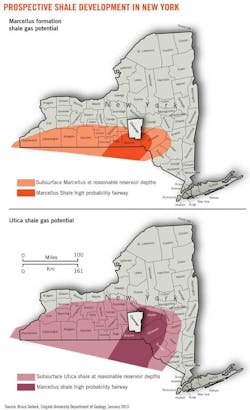CHENANGO COUNTY, NY—With no clear regulatory decision on the books, New York's local municipalities are enforcing constitutional rights to limit drilling activity within their borders.
Chenango County is located in the Southern portion of the state. Along with Tioga, Broome, and Delaware counties, it sits in high probability fairways for both the Marcellus and the Utica shale plays.
"Chenango County has development potential," said Steven Palmatier, a consultant employed by the county. "It's basically a multi-strata play with prospective acreage in the prime portion of the Utica sweet spot in the eastern central portion of the county and the Marcellus from the central portion to the north and south," he added. Both plays are located at producible depths with the Marcellus, ranging from 2,000 ft to 4,000 ft, and the Utica from 6,000 ft to 10,000 ft.
The nearly 50,000 residents of Chenango County are aware of the likelihood of oil and gas activity should hydraulic fracturing be allowed in the state. Yet, there is no consensus on whether or not a preemptive ban should be implemented. The Chenango County Chamber of Commerce recently performed a survey of its 400 members to determine who would benefit from oil and gas activity coming to the region. "Our membership was split pretty much right down the middle," said CEO Steve Craig, Chenango County Chamber of Commerce.
The Village of Oxford, located in the southern portion of the county, put forth a vote in January to ban drilling activity within the village, which encompasses approximately 1 sq mile. The village resides within the Town of Oxford, which encompasses 63 sq miles comprising mostly farmland. A source with the town's government stated that most of its residents are ambivalent to the village's proposed ban: "It doesn't make sense given that no hydraulic fracturing would likely take place within the village." The village's effort was an attempt to update its zoning law to specifically include oil and gas activity as prohibited. The request was denied by the Chenango County planning committee on the grounds that a "dire need" was not readily apparent. In addition, the "de facto" moratorium covered any such activity until a final decision was reached by the tate of New York. The current status on the Village of Oxford's ban on hydraulic fracturing is on hold; however, it is one example of how local residents are enforcing home rule throughout the state.
The real concern is how unconventional development will impact local communities. "If you have a lease available, it's certainly a huge impact," Craig said. "Although, others point out that the gas isn't going anywhere. ‘What's the rush?'" Smith describes the situation as "three-way," split with no unanimity.
To date, a few companies are continuing to secure leases. In Chenango County, the Herkimer sandstone has been in production for some time, with much of its gas coming from the Utica. "There are roughly 30 to 35 wells in production," Palmatier said. Norse Energy previously held 120,000 acres in the area that were sold to EmKey Energy. Chesapeake also is renewing leases in the region.
According to Palmatier, "You will see some activity should regulations be put into place as companies will want to secure their leases." A number of these will begin to expire in 2014 and even more the following year. To date, companies can perform hydraulic fracturing with up to 80,000 gal of water. Technically, this would cover one stage of a horizontal well. Yet, there is no indication that the economics make sense simply for the purposes of maintaining leaseholds. "Most companies are holding their cash to fully produce these shales," Palmatier said.
Natural gas prices and a more defined regulatory timeline will determine if New York follows Pennsylvania in terms of its resources.



